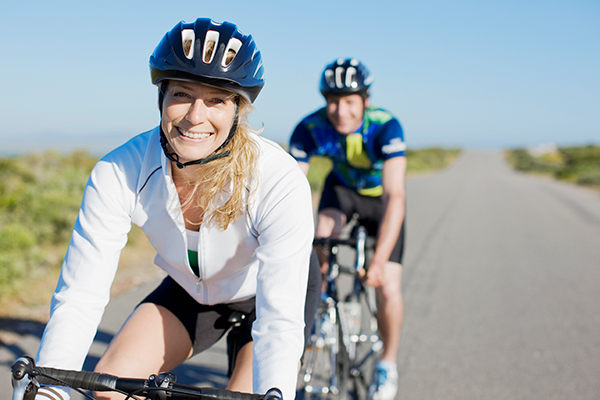This article follows up on member feedback about the impact of cycling on bone health.
Our original article on bike riding for the over 50’s could have been read as inferring that cycling can help address bone thinning. When a member reached out with feedback, we were happy to correct this, as it’s not quite what we meant. This also presented us with an opportunity to examine issues related to cycling and bone health that may be important to members.

The Biology Of Bone Density
Our bones are a matrix of flexible proteins and collagen stiffened by minerals – mostly calcium and phosphate. This combination helps keep our bones and skeleton stiff enough to hold us up, light enough to stay mobile but flexible enough to absorb impact.
The minerals in bones don’t just get deposited and stay there. Bones store minerals are re-absorbed and used again. Calcium is used to help nerves carry messages between the brain and other parts of the body, to help blood vessels move blood throughout the body and to help with the release of hormones and enzymes that affect how the body functions.
The Calcium Problem
Calcium is lost when we sweat, and the rate of loss increases with more profuse sweating. Normally the calcium is used by the body and replaced through dietary intake, but part of what promotes the re-depositing of calcium into the bones is weight-bearing exercise which places mechanical stress on the bones.
Running, jumping, kicking, punching and weight-lifting are weight-bearing forms of exercise, but road cycling in a seated position isn’t. Training hard for long distances and multiple years, increases the risk of developing osteopenia or osteoporosis, increasing the risk of fractures.
An extensive systematic review of studies (high quality evidence) found that adult road cyclists who trained regularly had lower bone mineral density in key regions (lumbar spine, pelvis, hip, and femoral neck) when compared with athletes in other sports and non-athletes. Mountain bike riders didn’t seem to be affected in this way. The vibration involved in navigating uneven terrain may place enough load on bones to have a protective effect.
The Cycling Solution
Some research suggests consuming 1000mg of calcium immediately before or during cycling and prevent bone demineralisation in endurance athletes. Strength training involving large muscle groups, plyometrics (rapid muscle exertion of maximum force) and activities like skipping, all promote the re-mineralisation of bones.
Cycling has many physical and mental health benefits, and adding exercises to help strengthen your bones can help you avoid potential risks.
“This was great feedback and a reminder to all of us of the benefits cross training and good diet can have on our health,” said General Manager of Public Affairs, Bastien Wallace.
“Bike riding is great but adding a more weight bearing exercise now can have great pay-offs and help prevent injury,” said Bastien.
Gyms may be closed at present but push-ups, squats, lunges and skipping don’t need special equipment. Booking a session with a personal trainer in the park can help you with ideas and technique, as well as supporting local business.
- Olmedillas, H., González-Agüero, A., Moreno, L.A. et al. Cycling and bone health: a systematic review. BMC Med 10, 168 (2012). https://doi.org/10.1186/1741-7015-10-168
- Scofield, Kirk L. MD, CAQ1,2; Hecht, Suzanne MD, CAQ, CCD1 Bone Health in Endurance Athletes: Runners, Cyclists, and Swimmers, Current Sports Medicine Reports: November/December 2012 - Volume 11 - Issue 6 - p 328-334 doi: 10.1249/JSR.0b013e3182779193
